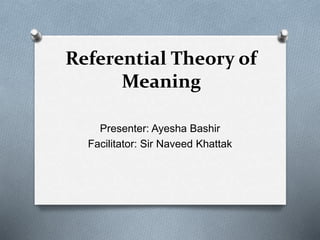
Referential theory of meaning
- 1. Referential Theory of Meaning Presenter: Ayesha Bashir Facilitator: Sir Naveed Khattak
- 2. Referential theory: Expressions stand for things/objects in reality • words function like labels, sentences mirror state-of- affairs O N designate objects, O V designate activities, O A designate properties Words are like labels. “Ali” denotes the person Ali. The word “ball” stands for ball. And the sentence “Ali kicked a ball” stands for Ali having kicked a ball, presumably because “Ali” denotes the person Ali, “kicked” stands for the act of kicking in the past, and “a ball” refers to a spherical object used in games.
- 3. Words/expression/signs objects/referent (this relationship is called reference) Principle of Compositionality: Putting individual references of the components of the sentence together produces a sentence as representing a particular state of affairs. E.g. the sentence: ‘Today is Monday’ means that today is Monday. Moreover this is because ‘today’ refer to present day, ‘is’ refers to the action of being and ‘Monday’ refers to the day which comes after Sunday.
- 4. Problem 1: words for imaginary objects some words don’t refer to anything that exists. “Pegasus” does not denote anything real, because there is no winged horse after all. Also, consider the sentence “I saw nobody.” But to what does “nobody” refer?
- 5. Problem 2: Semantic Intension The philosopher Frege pointed out a critical flaw using the phrases morning star and evening star. These phrases have the same referent, but different meanings. Using them in a sentence makes this difference obvious. The morning star is the morning star. The morning star is the evening star. The first of these sentences does not tell us anything new, while the second sentence does. A referential theory of meaning does not predict this difference. Frege distinguished between a word’s semantic extension and its semantic intension..
- 6. Problem 3: Referential Change O The things that words refer to seem to be changing constantly. A good example of this change is the name of a town, e.g., Lawrence. Lawrence has been continuously expanding since its beginning. It was even burnt to the ground once and rose from its ashes. Individual buildings in the town are constantly changing shape and color. The entity denoted by the name Lawrence is not the same from one day to the next. A strict interpretation of a referential theory of meaning would predict that the meanings of most names is constantly changing
- 7. Problem 4: Semantic Expertise Putnam alleges that many people cannot pick out the referents for many words. He claims that he cannot tell the difference between beech trees and elms even though he has used the words beech and elm for most of his life. A referential theory of meaning suggests that anyone would know the difference if they knew the meanings of the words beech and elm
- 8. The End
